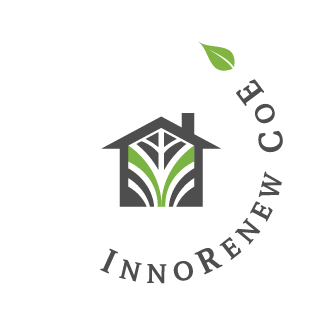
- PROJECT NUMBER: J2-2504 (Sicris)
- PROJECT TITLE: Autonomic edge computing for air quality monitoring
- PROJECT TEAM: Michael Mrissa, PhD (leader), Michael David Burnard, Aleksander Tošić, Miklós Ferenc Krész, David Balazs, Laszlo Hajdu
- PERIOD: 01.09.2020 – 31.08.2023
- BUDGET: €299,954.88 (€184,703.76 for InnoRenew CoE)
- FINANCING: Slovenian Research Agency (ARRS)
- PROJECT COORDINATOR: InnoRenew CoE (Slovenia)
- PARTNERS: UP FAMNIT (Slovenia); Institute for the Protection of Cultural Heritage of Slovenia (Slovenia)
Reducing the environmental, material and energy impacts of buildings is a major priority of the European Union [1] and is highlighted in the United Nation’s Sustainable Development Goals [2].
Buildings equipped with intelligent sensor systems (smart buildings), which can report the performance status of their elements to help optimize energy consumption and maintenance as well as inform future building design, are an important part of reaching this goal. Equipping buildings with wireless sensor networks (WSNs) is particularly helpful in contributing to this goal as well as improving the well-being of building users.
Typical approaches make use of cloud facilities for data upload and remote processing to manage buildings along their life cycle (conception, construction, use and end of life). Typical approaches present several drawbacks, however: dependency on cloud service providers, heavy network use, poor performance (network latency), privacy concerns due to remote computation and unsuitable data sharing strategies.
More recently, we have witnessed a drastic evolution of embedded devices that include more and more sensors, thus driving researchers to reconsider the typical cloud-based approach and distribute data and processes (back) to the network – a concept called edge (or fog) computing. Edge computing provides optimized network usage, dynamic network configuration and data management; it also enables distributed on-site data processing, low latency response to network changes and independence from cloud providers.
In this project, we will explore edge computing solutions that take advantage of a new generation of WSN devices, reducing the global environmental cost of such equipment. More specifically, we are exploring ways to combine theoretical tools (graphs and infection models), technologies (semantic web services, blockchain) and distributed data mining that can help in the design and implementation of dynamic self-configuring networks. The applicability of the approaches presented will be demonstrated with a set of pilot buildings of different types (public and private), geographic areas (Northern, Western, Central and Eastern Europe), living conditions and uses (residential and non-residential).
InnoRenew CoE project activities
InnoRenew CoE, as a project leader, will investigate ways to merge theoretical tools (graph and infection models), technologies (semantic web services, distributed ledger technology) and distributed data mining that may help design and implement dynamic self-configuring networks. We will demonstrate our work with four pilots in Slovenia and abroad.
[1] https://ec.europa.eu/energy/en/topics/energy-efficiency/buildings
[2] https://www.un.org/sustainabledevelopment/sustainable-development-goals/
Work packages and results
Work package 1: Coordination, project management, and dissemination
Task 1.1: Project coordination
Task 1.2: Project management and reporting
Task 1.3: Project communication
Deliverables:
- D1.1: Meetings minutes (each meeting)
- D1.2: Final project report (M36)
- D1.3: Communication material (M36)
Work package 2: Graph-based models for WSNs
Task 2.1: Development of hypergraph and diffusion models for WSNs
Task 2.2: Integration of heuristics, mathematical programming, and simulation solutions
into the model
Task 2.3: Implementation in distributed computational intensive environment
Deliverables:
- D2.1: Publication or technical report (M12)
- D2.2: Publications or technical reports (M24)
- D2.3: Prototype alpha and beta versions (M36)
Work package 3: Blockchain and semantic Web services
Task 3.1: State-of-the-art and design of a blockchain solution
Task 3.2: Design of semantic-driven service-oriented blockchain solution
Task 3.3: Implementation with use case and technical report
Deliverables:
- D3.1: Report – state-of-the-art (M12)
- D3.2: Publication or technical report (M28)
- D3.3: Prototype available (M36): [1] and [2]
Work package 4: Distributed data mining
Task 4.1: Identifying and selecting appropriate (state-of-the-art) distributed data
mining methods to be used for self-configuration and self-optimization of our sensor
network
Task 4.2: Identifying and selecting appropriate (state-of-the-art) distributed data
mining methods to be used for interesting pattern identification from sensor data
Task 4.3: Implementation of selected distributed data mining methods from tasks
T4.1 and T4.2 with use cases
Task 4.4: Integration of implemented distributed data mining methods as part of the
service APIs, testing
Deliverables:
- D4.1: Report – state-of-the-art in network traffic optimization (M14)
- D4.2: Report – state-of-the-art in distributed interesting patterns identification (M18)
- D4.3: Prototype available (M22)
- D4.4: Technical report (M32)
Work package 5: Use case and implementation
Task 5.1: State-of-the-art in wireless sensors related to building monitoring
Task 5.2: Sensor selection and placement in pilot buildings
Task 5.3 Data collection and integrated systems tests
Deliverables:
- D5.1: Report – state-of-the-art (M24)
- D5.2: Technical report (M26)
- D5.3: Prototype available (M36)
Report on project implementation (end of 2022)
Bibliografic references
- https://arxiv.org/abs/2111.14994
- https://www.ams.org/mcom/2021-90-332/S0025-5718-2021-03637-6/
- https://repozitorij.upr.si/IzpisGradiva.php?id=16699
- https://www.mdpi.com/0718-1876/17/1/16
- https://www.mdpi.com/1552412
- https://www.sciencedirect.com/science/article/pii/S2352711022000516
- http://publicatio.bibl.u-szeged.hu/26064/1/frontiers-built.pdf
- https://www.scores.si/assets/papers/6705.pdf
- https://www.mdpi.com/article/10.3390/en14217018
- https://link.springer.com/chapter/10.1007/978-3-031-15743-1_44
- https://ailab.ijs.si/dunja/SiKDD2022/Papers/SiKDD2022_paper_3754.pdf
- https://www.preprints.org/manuscript/202111.0489
- https://link.springer.com/chapter/10.1007/978-3-030-91608-4_55
- https://link.springer.com/chapter/10.1007/978-981-16-6269-0_46
- https://www.mdpi.com/1424-8220/21/20/6835
- https://link.springer.com/chapter/10.1007/978-3-030-85082-1_18
- https://www.mdpi.com/1660546
- https://journals.riverpublishers.com/index.php/JWE/article/view/12517
- https://link.springer.com/article/10.1007/s13278-021-00804-5
- https://onlinelibrary.wiley.com/doi/full/10.1002/jgt.22798
- https://www.mdpi.com/2076-3417/12/18/9055
- https://journals.riverpublishers.com/index.php/JWE/article/view/12519
- https://amc-journal.eu/index.php/amc/article/view/2467
- https://www.mdpi.com/2076-3417/12/4/2147
- http://www.doiserbia.nb.rs/Article.aspx?id=1820-02142300007A
- https://www.mdpi.com/2624-800X/1/1/9
- https://arxiv.org/abs/2112.01082
- https://dl.acm.org/doi/abs/10.1145/3571785.3574125



